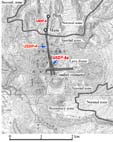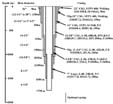 |
 |
 |
 |
 |
|
|
|
|
|
|
Objectives
In Unzen Volcano a huge volcanic disaster (15,000 were killed) occurred about 200 years ago and the latest eruption occurred in 1990-95. In the latter eruption, pyroclastic flows were produced due to partial collapses of a growing lava dome, threatening the lives of people around the volcano. It is important to understand not just when a volcano will erupt, but how it will erupt. A degassing process where the volatile component escapes effectively from magma during its ascent is the major factor controlling whether volcanism is explosive or non-explosive. The upper part of the magmatic conduit is believed to be the place where most degassing occurs. In-situ inspection of the conduit and its wall rock is the most effective approach to understand the mechanism. Drilling into the conduit of the latest lava dome at Unzen is a most desirable goal, because the lava that solidified in the conduit is still hot and the location of conduit is well defined by geophysical signals recorded intensively and precisely during eruption.
To understand magmatic processes in the upper conduit, we describe the scientific objectives as follows:
 |
 |
 |
 |
 |
|
|
|
|
|
|